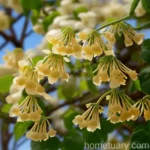What is the Dwarf Fothergilla (Fothergilla gardenii)?
Fothergilla gardenii, commonly known as dwarf fothergilla, is a deciduous flowering shrub native to the southeastern United States. It belongs to the Hamamelidaceae family and is prized for its showy, honey-scented blooms, vibrant fall foliage, and overall charm as a landscape plant.
Key Takeaways – Dwarf Fothergilla (Fothergilla gardenii):
- Scientific Name: Fothergilla gardenii
- Common Names: Dwarf fothergilla, Fothergilla, Witch alder
- Plant Type: Deciduous shrub
- Mature Height: 2-3 feet
- Mature Spread: 3-4 feet
- Bloom Time: Late spring to early summer
- Hardiness Zone: 5-8
Dwarf fothergilla is valued for its ornamental features and is a low-maintenance plant, making it a popular choice for gardens and landscapes.
Culture of Dwarf Fothergilla (Fothergilla gardenii):
Uses:
- Landscape Ornamental: Dwarf fothergilla is a favored plant for ornamental landscapes, adding beauty and interest with its flowers, fall color, and unique texture.
Water:
- Watering Needs: During the first growing season, ensure regular watering, especially during periods of drought. Once established, it is generally drought tolerant and does not require excessive watering.
Sunlight:
- Light Requirements: Dwarf fothergilla thrives in part shade to full sun, though it tends to achieve its best fall color in full sun conditions.
Fertilizer:
- Fertilizing: A yearly application of a balanced, slow-release fertilizer is beneficial in early spring to support healthy growth and blooming.
Soil:
- Soil Type: Well-draining, acidic soil is ideal for dwarf fothergilla. It does best in organically rich, moist soils but is adaptable to various soil types.
Pruning:
- Pruning Needs: Prune as needed in early spring after the threat of frost has passed. Remove any dead or damaged branches and perform light shaping to maintain the desired form.
Propagation:
- Propagation: Dwarf fothergilla can be propagated through softwood cuttings taken in early summer or through seeds, although the latter may take several years to develop into mature plants.
Container Popularity:
- Container Gardening: Due to its compact size and ornamental appeal, dwarf fothergilla is well-suited for container planting, adding interest to patios, decks, and small outdoor spaces.
Common Diseases and Pests:
Common Diseases:
- Leaf Spot: This fungal disease can cause spotting and browning of the leaves, typically in moist environments. Proper air circulation and avoiding overhead watering can help prevent this condition.
Disease Diagnosis:
- Visual Inspection: Regularly inspect the foliage for any signs of discoloration, spots, or abnormal growth. Address any issues promptly to prevent the spread of diseases.
Common Pests:
- Aphids: These small insects can infest the foliage, causing damage by sucking sap from the leaves. Insecticidal soaps or horticultural oils can be effective in managing aphid populations.
Botanist’s Tips:
- When selecting a planting location, consider the mature size of the shrub, allowing ample space for it to reach its full potential.
- To enhance fall color, plant in a location with full sun exposure. However, dwarf fothergilla can also thrive in part shade conditions.
- Regular watering is critical during the establishment phase. Once the plant is well-established, it exhibits good tolerance to drought conditions.
Fun Facts about Dwarf Fothergilla (Fothergilla gardenii):
- The name “fothergilla” honors Dr. John Fothergill, an 18th-century British botanist and physician.
- The fragrant, white bottlebrush-like flowers are a magnet for bees and butterflies, making it a valuable addition to wildlife gardens.
- Apart from its aesthetic appeal, dwarf fothergilla also offers significant ecological benefits by supporting pollinators and beneficial insects.
Links to External Resources:
- Missouri Botanical Garden – Fothergilla gardenii
- North Carolina State University – Fothergilla gardenii
Dwarf fothergilla (Fothergilla gardenii) is a delightful addition to gardens and landscapes, offering a range of ornamental attributes and requiring minimal care, making it a cherished plant among gardeners and horticulturists.















